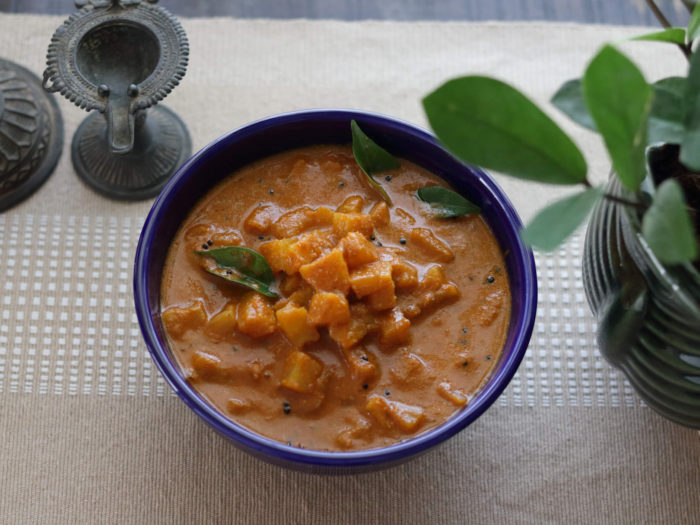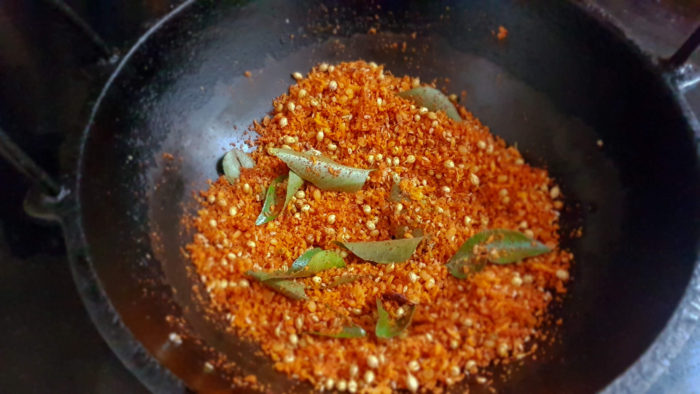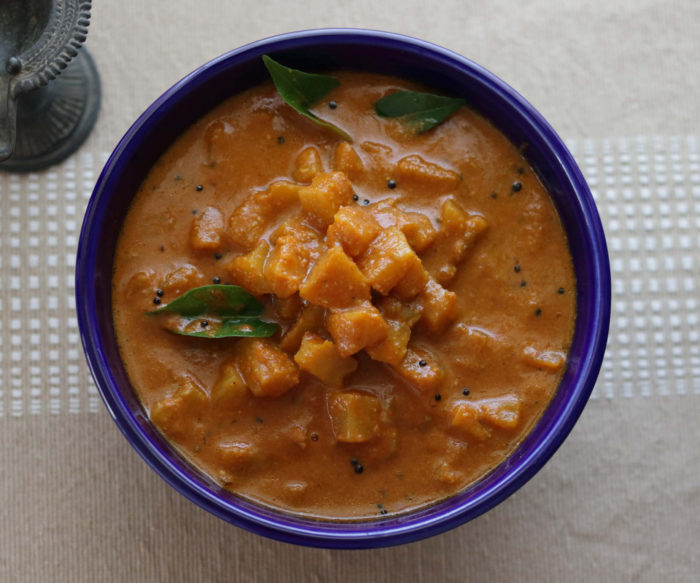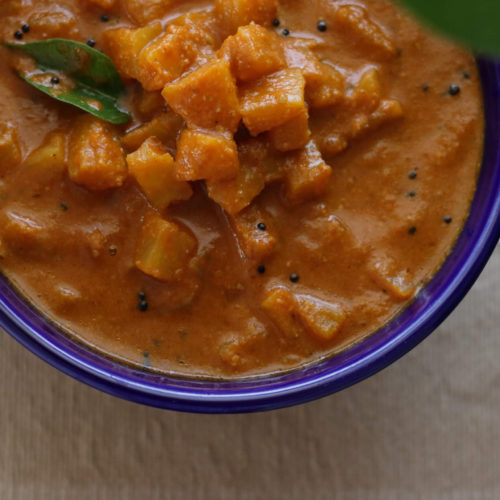This post on pineapple gojju, is about pinning a food memory from my Bengaluru school days on the blog. It’s a testimony to all the delicious gojjus – tomato, bitter gourd (bitter melon) and onion – that I ate at Kannada weddings and delicious, home-style meals. I used to visit my aunt on weekends (boarding school rules); and became great friends with her neighbour’s daughter and was lucky to share many of their lovely meals which always meant a large dollop of deep red gojju on my plate. A gojju is part curry and part pickle/chutney. It’s salty-sweet-sour notes still resonate in my brain and cooking pineapple gojju is a celebration of those indelible experiences.

Gojju is also a part of Tamil cuisine where it is known as gotsu. Tomato and brinjal (eggplant) being the favourites. That being said, I’ve seen recipes with many other vegetables being turned into gotsu on numerous food blogs. While the sweet-sour nature of the gotsu and the gojju remain intact, the main difference (that I see) is in the consistency – gojju is jammy,thick and chutney-like, while gotsu resembles a curry. Also the combination of spices in the ground masala varies somewhat. I’d love to know more about these variations from those of you with greater knowledge of this dish.
The thickish base of gojju is composed of a ground masala paste/powder (some people keep the spice mix dry while others add water to make a paste). This is the soul of the gojju – the punchy aroma and typical flavours are formed in the crucible that is your grinder, when the spices come together to meld into one entity. Never fails to amaze me how different combinations of the same spice can produce completely unlike masala pastes/powders. That knowledge is the treasure of a maestro. The pineapple gojju masala has a little grated fresh coconut, coriander seed, fresh curry leaves, whole or powdered Kashmiri red chillies (hence the gentle heat and rich colour), white sesame seed, urad dal (skinless black gram) and fenugreek seed.

While gojju can be eaten as an accompaniment with breakfast staples like idli, dosa, upma, pongal etc, it’s versatile and is often included as part of a larger thali with rice, sambar, vegetables etc. I think it brings a little oomph to the meal; it’s one of those preparations that makes you unconsciously lick your fingers (undoubtedly, it’s the sweet and sour sauciness at work). Pineapple gojju has an enhanced level of acid-rimmed sweetness, a flavour and fragrance combination that needs a separate name.

Now this pineapple gojju recipe is my own and I’m sure there are many recipes out there that have a little more of this or a little less of that or a couple of extra ingredients. There is no one ‘authentic’ recipe that is the gospel (at least as far as I know). That said, I welcome suggestions and contributions that may help me understand and cook the perfect gojju. Use a sweet, ripe pineapple for that perfect balance of sweet and sour. But if your pineapple is slightly under, increase the quantity of jaggery in the recipe. You’re looking for a well rounded, sweetness with mellowed sour notes on its fringes, not sharp lashings of acid.
We ate the pineapple gojju with rice and ghee, a vegetable poriyal and dal. At the end of the meal I couldn’t resist one last tiny helping that I slowly relished,one finger-lick at a time.

Pineapple Gojju
Ingredients
- 1 ripe pineapple, peeled, cored and diced
- 1 lemon-sized ball of tamarind soaked in enough water to cover it
- 3 tbsp jaggery powdered
- 5-7 curry leaves
- 1/4 tsp turmeric powder
- 1 tsp black mustard seeds
- 1½ tbsp vegetable oil
- 1/8 tsp asafoetida powder or hing
- Salt
For the masala paste
- 1 tbsp skinless black gram or urad dal
- 5 tbsp grated fresh coconut
- 1/4 tsp fenugreek seeds or methi
- 1 tbsp Kashmiri chilli powder
- 2 tsp coriander seeds or dhania
- 2 tsp white sesame seeds
- 5 curry leaves
Instructions
- Heat ½tsp oil in a pan and on low heat, gently toast the ingredients for the masala paste for about 2 minutes, till fragrant, adding the Kashmiri chilli powder only in the last 20 seconds . Stir continuously taking care to not burn the spices.
- Cool the spices for 5 minutes before grinding them to a thick, smooth paste using a little water.
- In the same pan, tip in the pineapple, add a cup of water, turmeric and salt, and cook for 10 minutes till the fruit is somewhat tender.
- Now add the masala paste, and jaggery (adding a little more water if necessary), stir well and simmer for a further 10 minute till everything is well combined and you have a thickish sauce. Turn off the heat.
- In a smaller pan, heat the remaining oil till hot and temper with mustard seeds, asafoetida and curry leaves till they crackle. Pour this tempering over the cooked gojju and mix.





2 Comments
Simi Bali
October 31, 2020 at 10:39 pmLoved cooking it & eating it!
quichentell
November 2, 2020 at 12:56 pmThank you Simi 😀